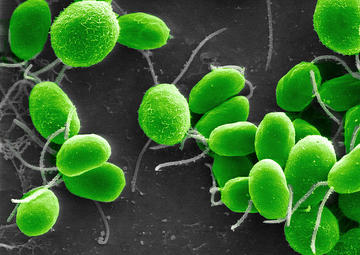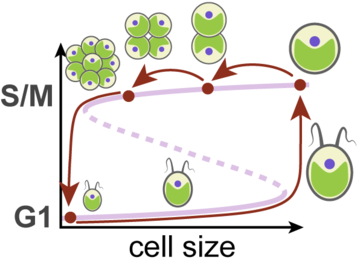A new paper entitled "A Single Light-Responsive Sizer Can Control Multiple-Fission Cycles in Chlamydomonas", by Stefan Heldt, Béla Novák and their coauthors John Tyson (Virginia Tech) and Fred Cross (Rockefeller Univ), is published in Current Biology. The unicellular green alga, Chlamydomonas reinhardtii (Fig.1), has a unique mode of cell growth and division. During daylight hours, cells grow eight-fold (or more) without DNA synthesis or cell division; and then, during the night, these cells undergo multiple cycles of DNA replication, mitosis and cell division, producing up to eight daughter cells, which then wait patiently for dawn to break. Algal-cell physiologists have speculated for years about "commitment points", "time delays" and other processes that might account for these multiple-fission cycles in Chlamydomonas. The Novák's group and their colleagues present the first mathematical model of this division-control system, based on common properties of the cyclin-dependent kinases that govern progression through the eukaryotic cell cycle.
In a series of papers over the past 25 years, Novák and Tyson have shown that this control system is characterized by a size-dependent bistable switch that regulates a size-independent cell-cycle oscillator (G1-S-G2-M-G1-…). For most cells, the cell-cycle oscillator makes one complete revolution each time the size of the cell increases two-fold, thereby maintaining a roughly constant nucleocytoplasmic ratio (within a factor of two). Photosynthetic "Chlamy" cells adopt a different strategy. They grow as rapidly as possible while the sun is shining, wasting no time or energy on DNA synthesis and cell division; then at night, when further growth is impossible, they used stored energy and material to make new, daughter cells. In the view of Heldt et al., the light-dependent, bistable switch (the "sizer") blocks rotations of the cell-cycle oscillator during the day (Fig.2); and then, during the night, the block is lifted, allowing multiple rounds of DNA replication and division, until cells reach a small size characteristic of Chlamy cells at dawn. The mathematical model specifies exactly how cells measure their size, in order to maintain a functional balance of cytoplasmic proteins and nuclear DNA. The model makes novel predictions about Chlamy cell growth and division in variable light-dark regimes; predictions that have been confirmed by elegant experiments in Fred Cross's lab.

Figure 1: Chlamydomonas reinhardtii is a unicellular green algae

Figure 2: A wide bistable sizer mechanism leads to multiple-fission cycles
Reference:
Heldt, F.S., Tyson, J.J., Cross, F.R. & Novák, B: A Single Light-Responsive Sizer Can Control Multiple-Fission Cycles in Chlamydomonas. Current Biology. Link: https://doi.org/10.1016/j.cub.2019.12.026
Béla Novák and John J. Tyson
January 2020